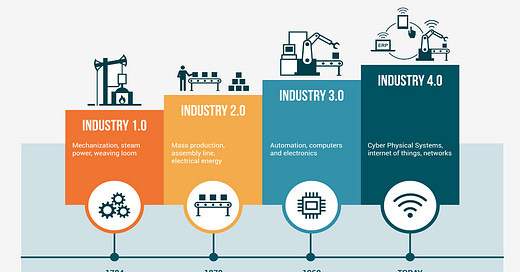💎1st Anniversary Edition🎉: Will AI destroy more jobs than it creates?
Hello,
Can you believe that it’s a year already?!🎉 On the 4th of July, 2020, I sent out the first edition of this newsletter. It was yet another pandemic experiment that has now turned into a habit.
26 editions later, I no longer set any reminders to draft the ‘Spotlight’ or to collect nuggets for the ‘Industry Roundup’. It’s all internalized, and I enjoy putting every edition together.
Thank you for taking the time to read, engage, and respond over the year 🙏 There’s one favor I ask of you now. Would you please fill this short survey (just 2-minutes!) to help me improve the newsletter? I’d love to hear from you -> Click for Survey
The anniversary edition💎 won’t be complete without some stats 😉 Here are the top 3 editions in terms of:
Most liked: What can Cinderella teach you about data storytelling?👸
Most opened (email): Will you let a Robot test you for COVID-19?😷
Most viewed: No, AI won't change our world. Not until you find it boring🥱
This newsletter will take you about 5 minutes to read.
I. Spotlight: Will AI destroy more jobs than it creates?
We have seen three industrial revolutions so far. Every single one of them created more jobs than those they automated away.
When horses were replaced by cars, it created the automobile industry that continues to employ millions worldwide. However, experts doubt whether this will continue with AI-driven automation in the fourth industrial revolution that’s underway.
(Picture: Timeline of the industrial revolutions; Source - Momentum)
I recently spoke to Kevin Roose, NYT tech columnist and author of the book “Futureproof. Pointing to the exponential advances in AI, he says, “As machines learn to be better on their own, humans will eventually become a drag on the efficiency of the system.”
We already have organizations such as Ant Financial that are built around an entirely digital core. AI runs the show, and there are no workers in the “critical path” of operating activities. There is no manager approving loans, no employee providing financial advice, no representative authorizing consumer medical expenses.
You might argue that humans are needed to perform critical tasks even in such a hyper-automated business. Yes, Ant Financial still needs humans to design workflows, oversee decisions, or step in during exigencies. But, this is just a fraction of the workforce they would have otherwise employed.
Compared to JPMorgan Chase, the financial organization that employs a global headcount of 250,000, Ant Financial staffs less than 10% of this workforce. However, Ant Financial was valued at around $220 Billion at the end of 2020 - almost half that of JPMorgan.
This comparison misses one important point, though.
AI creates jobs asymmetrically
(Photo by Levi Midnight on Unsplash)
For every function that AI automates away, it creates entirely new disciplines, and hence jobs. We’ve seen how the internet led to completely new jobs in sunrise industries, such as web development and search engine optimization (SEO).
Roose expresses his doubts about this hypothesis. He cites the research of MIT Professors Daron Acemoglu and Pascual Restrepo. The economists agree that the loss of jobs to automation is often balanced by the creation of new tasks. This is called the reinstatement effect.
However, their research shows that in the past 30 years, the creation of new tasks isn’t keeping pace with the automation of old ones. This makes us wonder whether the scales have really started to tip towards net job loss.
I came across a recent paper, again by prominent MIT economists, that analyzes AI’s specific impact on US job vacancies over the past ten years. It found that organizations that use AI have cut down recruitment for many of their positions. However, the same firms expanded hiring for their AI roles.
What’s the conclusion? While AI is substituting for humans in a subset of tasks, it isn’t hurting jobs at the aggregated industry level. At least, not yet.
However, the economists add a note of caution. How this balance of AI job gain vs. loss will play out in the long term is dependent on factors such as corporate strategies, supply of needed skills, regulations, and institutions like labor unions. This is something that Roose and I readily agree on.
The takeaway is that with the responsible adoption of AI, it is possible to take care of the jobs. Yes, we can have the cake, and eat it too!
What are the implications for executives and organizations? My latest for Forbes shares a 4-step approach on how to adopt AI while protecting your employees.
II. Industry Roundup:
1. MIT Chief Data Officer event (CDOIQ) - Promo code for 75% off
The MIT CDOIQ symposium is a highly anticipated annual event for data leaders. This year’s event is on July 20-22 and has panels discussing topics such as operationalizing AI, what’s next for the CDO role, and how to measure ROI from data. Use this special promo code to get 75% off while you register: 2021Friend75%
-> Register for the Event (Promo code active until July 15th)
2. AI can Now Taste - How wine-making is getting a makeover
5 minutes | Forbes | Bernard Marr
Tastry, a sensory sciences company in California, combines machine learning and advanced chemistry to teach AI to “taste.” It decodes aroma and flavor profiles by chemically analyzing thousands of wines in its lab. Then it identifies unique consumer palates when people take a quiz. The AI then uses both of these datasets (consumer palate data and wine profiles) to predict wine preferences with over 92% accuracy.
III. From my Desk:
1. Article: 4 novel ways to build AI talent in-house
6 minutes | The Enterprisers Project
The top challenge most organizations face with AI is in hiring their team. When external talent is scarce or comes at a heavy premium, you can use 4 uncommon yet practical ways to groom internal talent. Check out the examples from industry leaders.
2. Podcast: Decision intelligence and data storytelling
32 minutes | Aktana
What's the last-mile disconnect in decision intelligence? Can AI solutions benefit from storytelling? How can you ensure ROI from data? Clay Hausman, the CMO Of Aktana and I chat about these and more in this episode.
3. Video: How questions can help you navigate your data journey
6 minutes | Gramener
Questions are powerful. Your questions can give a vital clue on where you are in your data science journey. This whiteboard shares the common questions organizations ask and what it indicates about your data maturity. With a business example, you'll learn how to navigate the typical challenges your teams face.
When automation goes wrong! The hospital temperature sensor denies physician access into the building because it’s 100°F on a hot day, and it thinks she has a fever. 😐
Thank you for subscribing and reading the newsletter. I appreciate your attention,
Ganes.
PS: Did someone forward this to you? You can subscribe here.
My Website | LinkedIn | Twitter | YouTube
I’m Ganes Kesari. I publish ‘Data-Driven Future’ to help understand how data shapes our world, explore key trends, and explain what they mean for you today. I speak and write to demystify data science for decision-makers and organizations.
Recent Issues:








